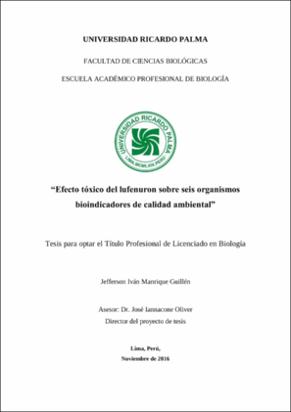Mostrar el registro sencillo del ítem
Efecto tóxico del lufenuron sobre seis organismos bioindicadores de calidad ambiental
| dc.contributor.advisor | Iannacone Oliver, José | |
| dc.contributor.author | Manrique Guillen, Jefferson Iván | |
| dc.date.accessioned | 2017-05-30T21:15:08Z | |
| dc.date.available | 2017-05-30T21:15:08Z | |
| dc.date.issued | 2016-11 | |
| dc.identifier.uri | https://hdl.handle.net/20.500.14138/894 | |
| dc.description.abstract | El lufenuron un insecticida del grupo de los benzilureas, el cual interfiere con la síntesis de la quitina que causa una inhibición en la muda de los insectos. Se evaluó el efecto tóxico del lufenuron sobre seis organismos bioindicadores de calidad ambiental. Se desarrollaron los bioensayos con el lufenuron sobre seis organismos bioindicadores de calidad ambiental: Chlorella vulgaris (Beijerinck, 1890), Artemia franciscana (Kellogg, 1906), Daphnia magna (Straus, 1820), Carassius auratus (Linnaeus, 1758), Microorganismos de Suelo y Eisenia foetida (Savigny, 1826). Se utilizó el análisis de varianza (ANDEVA) con prueba de Tukey y con el Probit se calcularon los parámetros ecotoxicológicos. Los resultados son los siguientes, C. vulgaris (CI50<2,46 mg i.a.·L-1 a 96 h), A. franciscana (CL50= 11,41 μg i.a.·L-1 a 48 h), D. magna (CL50= 0,05 μg i.a.·L-1 a 48h), D. magna (NOEC= 0,00005 mg i.a.·L-1 / LOEC= 0,0001 mg i.a.·L-1 para el numero de crías vivas a 21 d), C. auratus (NOEC= 0, 061 mg i.a.·L-1/ LOEC= 0.122 mg i.a.·L-1 para el porcentaje de mortalidad acumulada a 26 d), Microorganismos de Suelo (NOEC= 1820 mg i.a.·g-1 / LOEC> 1820 mg i.a.·g-1) y E. foetida (DL50= 206,31 mg i.a.·Kg-1 a 14 d ; NOEC< 21,2 mg i.a.·Kg-1 / LOEC= 21,2 mg i.a.·Kg-1 a 14 d). Se observó la siguiente secuencia de ecotoxicidad decreciente mediado por los efectos letales y subletales producidos durante los bioensayos con los seis organismos: D. magna > A. franciscana > C. vulgaris > C. auratus > E. foetida > Microorganismos del suelo. Daphnia magna fue el organismo bioindicador más sensible al lufenuron y el más resistente fueron los microorganismos del suelo. El lufenuron presentó mayores porcentajes de mortalidad e inhibición en los organismos acuáticos que en los terrestres. Se concluyó que los seis organismos escogidos para evaluar los posibles daños ambientales del insecticida lufenuron, ayudaron a clarificar que este compuesto daña principalmente la cadena trófica acuática que la terrestre, siendo más sensibles los ecosistemas acuáticos que los terrestres que presentan riesgo bajo. Lufenuron is an insecticide from the group of benzylureas, which interferes with the synthesis of chitin causing inhibition of insect moulting. The toxic effect of lufenuron on six environmental quality bioindicator organisms was evaluated. Bioassays with lufenuron were developed on six environmental quality bioindicators: Chlorella vulgaris (Beijerinck, 1890), Artemia franciscana (Kellogg, 1906), Daphnia magna (Straus, 1820), Carassius auratus (Linnaeus, 1758) and Eisenia foetida (Savigny, 1826). The analysis of variance (ANDEVA) was used with Tukey's test and with the Probit we calculated the ecotoxicological parameters. The results are as follows: C. vulgaris (IC50 <2,46 mg i.a.·L-1 at 96 h), A. franciscana (LC50 = 11,41 μg i.a.·L-1 at 48 h), D. magna LC50 = 0,05 μg i.a.·L-1 at 48 h), D. magna (NOEC = 0,00005 mg i.a.·L-1 / LOEC = 0,0001 mg i.a.·L-1 for the number of live offspring at 21 d), C. auratus (NOEC = 0,061 mg i.a.·L-1 / LOEC = 0.122 mg i.a.·L-1 for the percentage of accumulated Mortality at 26 d), Soil Microorganisms (NOEC = 1820 mg i.a.·g-1/ LOEC> 1820 mg i.a.·g-1) and E. foetida (LD50 = 206,31 mg i.a.·kg-1 at 14 d; NOEC <21,2 mg i.a.·kg-1 / LOEC = 21,2 mg i.a.·kg-1 at 14 d). The following sequence of decreasing ecotoxicity mediated by the lethal and sublethal effects produced during the bioassays with the six organisms was observed: D. magna> A. franciscana> C. vulgaris> C. auratus> E. foetida> Soil microorganisms. Daphnia magna was the most bioindicator organism of lufenuron, and the most resistant soil microorganisms. Lufenuron had higher rates of mortality and inhibition in aquatic organisms than in terrestrial organisms. It was concluded that the six organisms chosen to evaluate the possible environmental damages of the insecticide lufenuron, helped to clarify that this compound damages mainly the trophic chain aquatic that the terrestrial chain, being more sensitive aquatic ecosystems that the terrestrial ones. | es_ES |
| dc.description.sponsorship | Submitted by Wong Rafael (rafel_wl@hotmail.com) on 2017-05-30T21:15:08Z No. of bitstreams: 1 Manrique_ji.pdf: 1456505 bytes, checksum: 4f929636f0405ce2f7f39f4b64d395fc (MD5) | es_ES |
| dc.description.sponsorship | Made available in DSpace on 2017-05-30T21:15:08Z (GMT). No. of bitstreams: 1 Manrique_ji.pdf: 1456505 bytes, checksum: 4f929636f0405ce2f7f39f4b64d395fc (MD5) Previous issue date: 2016-11 | es_ES |
| dc.description.uri | Tesis | es_ES |
| dc.format | application/pdf | |
| dc.language.iso | spa | |
| dc.publisher | Universidad Ricardo Palma - URP | es_ES |
| dc.rights | info:eu-repo/semantics/openAccess | |
| dc.rights.uri | https://creativecommons.org/licenses/by-nc-nd/4.0/ | |
| dc.source | Repositorio Institucional - URP | es_ES |
| dc.subject | lufenuron | es_ES |
| dc.subject | calidad ambiental | es_ES |
| dc.subject | bioensayos | es_ES |
| dc.subject | bioindicadores | es_ES |
| dc.subject | environmental quality | es_ES |
| dc.subject | bioassays | es_ES |
| dc.subject | bioindicators | es_ES |
| dc.title | Efecto tóxico del lufenuron sobre seis organismos bioindicadores de calidad ambiental | es_ES |
| dc.type | info:eu-repo/semantics/bachelorThesis | |
| thesis.degree.discipline | Biología | es_ES |
| thesis.degree.grantor | Universidad Ricardo Palma. Facultad de Ciencias Biológicas. Escuela Profesional de Biología | es_ES |
| thesis.degree.level | Título Profesional | es_ES |
| thesis.degree.name | Licenciado en Biología | es_ES |
| dc.publisher.country | PE | es_ES |
| renati.type | https://purl.org/pe-repo/renati/type#tesis | |
| renati.level | https://purl.org/pe-repo/renati/nivel#tituloProfesional | |
| renati.discipline | 511206 | |
| dc.type.version | info:eu-repo/semantics/publishedVersion |
Ficheros en el ítem
Este ítem aparece en la(s) siguiente(s) colección(ones)
-
Biología [176]


